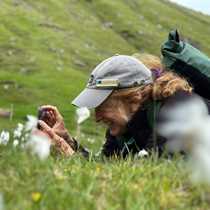Columbia River
We woke to a foreign landscape this morning. We were no longer amongst the tree studded hills of Portland. We were no longer amongst the exuberant display of trunks and branches reaching skyward, festooned with the colorful, leafy trappings of fall. We were surrounded by naked basaltic cliffs, partially shrouded within low lying clouds and bordered by vast expanses of short-cropped dried grasses.
The mystery invoked by this landscape perplexed and added more than a little consternation to Meriwether Lewis and William Clark’s days. They headed west in 1803, carrying a map with significant gaps of information. The latitude and longitude of the Mandan village site on the Missouri river was a known point, as well as the mouth of the Columbia River and the city of St. Louis. It would be William Clark’s task to reveal the mysteries of several hundred miles of the unmapped landscape that stretched between these three points.
We drew on our own maps while orienting ourselves to this new landscape. With the aid of a continuous GPS chart displayed in our lounge we always knew where we were and what was ahead- a luxury unheard of when five freshly made canoes came down this same river in the fall of 1805.
With the afternoon came clear skies and a comfortable warmth to the outside decks. The only mystery remaining for the day was which would become your favorite wine, tested at our regional foods gala, or how many smoked mussels could fit on a tiny plate. With a full moon rising in the east, and the rosy glow of sunset to the west, we continued our course towards the mysteries and adventures of tomorrow.
We woke to a foreign landscape this morning. We were no longer amongst the tree studded hills of Portland. We were no longer amongst the exuberant display of trunks and branches reaching skyward, festooned with the colorful, leafy trappings of fall. We were surrounded by naked basaltic cliffs, partially shrouded within low lying clouds and bordered by vast expanses of short-cropped dried grasses.
The mystery invoked by this landscape perplexed and added more than a little consternation to Meriwether Lewis and William Clark’s days. They headed west in 1803, carrying a map with significant gaps of information. The latitude and longitude of the Mandan village site on the Missouri river was a known point, as well as the mouth of the Columbia River and the city of St. Louis. It would be William Clark’s task to reveal the mysteries of several hundred miles of the unmapped landscape that stretched between these three points.
We drew on our own maps while orienting ourselves to this new landscape. With the aid of a continuous GPS chart displayed in our lounge we always knew where we were and what was ahead- a luxury unheard of when five freshly made canoes came down this same river in the fall of 1805.
With the afternoon came clear skies and a comfortable warmth to the outside decks. The only mystery remaining for the day was which would become your favorite wine, tested at our regional foods gala, or how many smoked mussels could fit on a tiny plate. With a full moon rising in the east, and the rosy glow of sunset to the west, we continued our course towards the mysteries and adventures of tomorrow.




